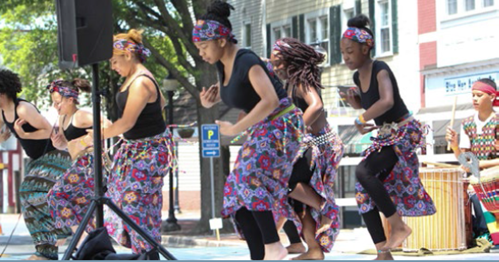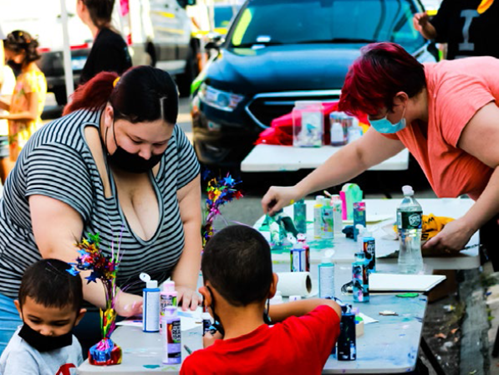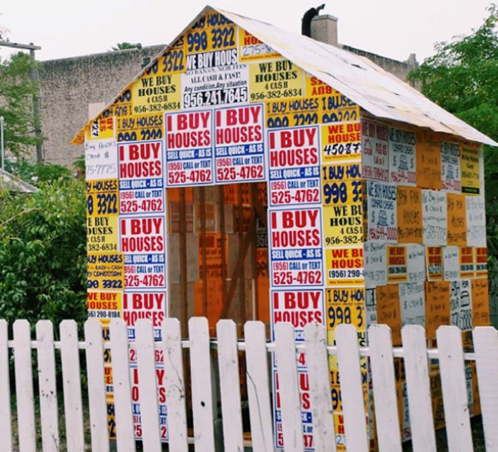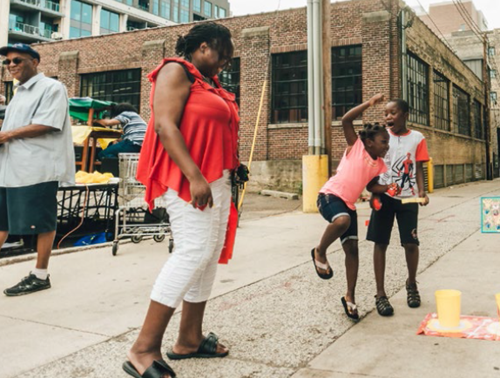Since 2017, with generous support from the Kresge Foundation, NeighborWorks America has strategically invested in creative community development within its network of nearly 250 nonprofits.
 "Creative community development can contribute to many comprehensive community development goals and strategies," says Paul Singh, NeighborWorks' vice president of Community Initiatives. "Many network organizations are undertaking arts and culture-based efforts in order to engage residents, build community, create awareness, forge partnerships, beautify public spaces, honor history and culture, revitalize neighborhoods, promote economic growth and lift up voices that often are not heard."
"Creative community development can contribute to many comprehensive community development goals and strategies," says Paul Singh, NeighborWorks' vice president of Community Initiatives. "Many network organizations are undertaking arts and culture-based efforts in order to engage residents, build community, create awareness, forge partnerships, beautify public spaces, honor history and culture, revitalize neighborhoods, promote economic growth and lift up voices that often are not heard."
What else does creative community development offer?
Elizabeth Druback Celaya, NeighborWorks' director of Community Initiatives, adds, "It offers new ways of seeing and thinking about a community’s challenges and opportunities. In order to be most effective, comprehensive community development needs to bring people together in dialogue to create shared strategies. Arts and culture-based efforts can do this in ways that are often more accessible than traditional modes of public engagement, and they can provide a new lens through which people can see and learn about each other, their community and what they can accomplish collectively."
Pilot project looks at outcomes
In a parallel effort, also supported by The Kresge Foundation, Success Measures' evaluation group at NeighborWorks America worked with eight NeighborWorks network organizations to evaluate ongoing creative community development activities, including community gardens, mural projects, public art at a local nature trail and artist-in-residence programming. For this pilot project, each organization was paired with an evaluator to guide them and help build evaluation capacity within the organization. The cohort received grant support and training from NeighborWorks America, as well as access to measurement tools focused on arts and culture, including two new creative methods tools — weaving and mapmaking — to help understand community change.Supplementing the evaluation process, organizations participated in unique creative reflection activities, including poems and digital illustrations, to capture their feelings about this experience in real time. "Evaluating Creative Community Development: A Learning Brief" shares the experience, outcomes, challenges and important lessons of participating organizations, accompanied by photos, quotes, poems and illustrations to help others in the field who might be exploring creative community development work and evaluation.
"We are finding there is exciting potential in using arts methods to better understand community. For example, the Success Measures tool that guides individuals through a weaving project helps reveal social connections among the community members," says Jessica Mulcahy, director of philanthropic evaluation strategies at Success Measures. And the organizations who are evaluating their creative community development efforts by engaging residents in these focused creative activities are gaining important insights and understanding about the benefits of their programs."
Arts across the network
In 2022, nearly a third of NeighborWorks network organizations had arts programs and partnerships in place. To support these efforts, NeighborWorks convened more than 80 staff from 32 network organizations to participate in peer learning conversations. NeighborWorks was also interested in learning more about how organizations adapted their work during the pandemic.The most common creative community development projects across the network included:
- Creative classes
- Creative use of public space
- Community events and relationship building
Creative classes: Spotlight on New Kensington Community Development Corporation
 Creative classes and workshops provided opportunities for building new skills as well as social connections within a community, even when they take place virtually. We heard examples of workshops, trainings and classes in everything from visual art to photography, improv/acting, drumming and ceramics. Most of these sessions were led by local artists/creatives in the community.
Creative classes and workshops provided opportunities for building new skills as well as social connections within a community, even when they take place virtually. We heard examples of workshops, trainings and classes in everything from visual art to photography, improv/acting, drumming and ceramics. Most of these sessions were led by local artists/creatives in the community. New Kensington Community Development Corporation (NKCDC) in Philadelphia, Pennsylvania, in partnership with Mural Art Program, began a series of art exhibitions called From Kensington with Love. This group exhibition focused on the voices of Kensington residents from diverse sectors who shared their stories, experiences, and visions with community artists during five workshops. NKCDC hosted workshops at various locations to ensure that voices from the entire Kensington community were represented and included pottery and art classes. The work showcased the tenacity, healing, creativity, strength, hope and beauty that permeate the community. The narratives and messages were revealed through a tapestry of mixed media, painting and photography by artists.
Creative use of public space: Spotlight on cdcb | come dream. come build.
 "Arts and culture-bearers are often drivers of innovation," says Druback Celaya. "Engaging these individuals, organizations and institutions helps embed a sense of inquisitiveness, discovery and creativity into community development – attributes that are necessary to help both kindle and sustain long-term change, particularly when tackling entrenched, seemingly insurmountable challenges."
"Arts and culture-bearers are often drivers of innovation," says Druback Celaya. "Engaging these individuals, organizations and institutions helps embed a sense of inquisitiveness, discovery and creativity into community development – attributes that are necessary to help both kindle and sustain long-term change, particularly when tackling entrenched, seemingly insurmountable challenges."Public art allows a community to preserve the culture and identity of a place and the residents who live there. Murals and community gardens were frequently cited as successful and beloved projects in communities — and they had the added benefit of allowing individuals to work outside, socially distanced during the pandemic. NeighborWorks network organizations also shared examples of reclaiming and revitalizing community spaces such as parks and alleys.
cdcb | come dream. come build. in Brownsville, Texas, developed an art installation titled, "The Myth of Affordability in the RGV." The Rio Grande Valley had a reputation as a very affordable place to live but most residents of the area had a different experience. During the height of the pandemic, there was added concern that those who did own homes would try to sell due to increased financial uncertainty. So cdcb worked with a local artist to remove "we buy houses!" bandit signs from street intersections in the Rio Grande Valley. These signs were used as an illegal guerrilla marketing tactic by real estate investors and house flippers. The artist then used the signs to build a house that visualizes the risk of displacement in the community. The resulting structure not only helped to clean up visual trash in the community but also countered the mainstream talking points about housing accessibility and affordability in the area.
Community events and relationship building: Spotlight on Dwelling Place
 Community events and celebrations such as neighborhood art walks, resident art exhibits and concert series, among others, are used to increase connection and a sense of shared identity with residents. Far from one-off activities, these events often become annual festivals, monthly marketplaces and other sustained initiatives for relationship building and resource sharing.
Community events and celebrations such as neighborhood art walks, resident art exhibits and concert series, among others, are used to increase connection and a sense of shared identity with residents. Far from one-off activities, these events often become annual festivals, monthly marketplaces and other sustained initiatives for relationship building and resource sharing. Dwelling Place in Grand Rapids, Michigan, organized the Anywhere But Home Door Decorating Competition in one of their apartment communities during the peak of the pandemic. The at-home social event combined a locally catered meal, delivered directly to 75 residents’ doors, and a door-decorating competition. Residents signed up to have decorating supplies delivered to their apartments and were encouraged to display a vision of their dream vacation. Selected winners received gift certificates. The door décor spread neighborly cheer and inspired staff from a Grand Rapids Dwelling Place property to host their own door decorating competition. In addition, the team created a series of recommendations for activating a nearby park together.
Challenges
Flexible and Responsive Funding: Funding for creative community development needs to be more flexible, participants agreed. Many funders only fund specific projects which limits the ability of communities to work on long-range planning and broader scopes of work. Another related challenge is that few funders offer flexibility around shifting timelines or scopes of work that continue to evolve based on community input. Lastly, funds to support local leaders and resident artists with stipends are difficult to find.Organizational Support and Staff Turnover: Creative community development requires support from across an organization and needs to be integrated with other organizational goals and priorities. Like many other fields, community development is experiencing high rates of staff turnover, so broad organizational support is necessary to ensure that projects and partnerships have continuity beyond any one individual.
Community Engagement: Creative community development should center the voices of those who would benefit the most from such efforts. While many organizations recognized this, they also struggle with sustaining engagement beyond one meeting or event. Much of this was attributed to the unique challenges posed by the last three years of the pandemic and the undue burdens that many of the communities served by the NeighborWorks network experienced.
"Arts and culture can reflect back to people who they are, which helps identify strengths as well as opportunities for change," says Druback Celaya. "I think of an experience I had where an artist built a temporary structure out of cardboard on a vacant lot. Over the course of a season, the structure slowly disintegrated and faded away as it was exposed to the elements. This piece told a story about change and loss in a neighborhood where gentrification was taking place, and it sent a message about how we see — or don’t see — the very things that are right in front of us, even as they disappear. That is a powerful message, and that can galvanize people to think differently."
Key Takeaways
- The question has moved from "How do I start this work?" to "How do I continue to do this work better?"
- More network organizations and community members recognize and understand the value and impact of creativity and artistic practice in community development.
- Network organizations have more active partnerships with artists and culture bearers in their communities.
- Network organizations prioritize community building with residents. They recognize that it is an integral part of the process rather than an extra step.
- One-off projects are becoming ongoing programs that are led by residents, artists and other "non-traditional" staff members.
- Overall, the quality of conversation in 2022 is more in-depth and process-oriented. Organizations are looking to better integrate creative processes and practices throughout their work.
- Resources that the network has found valuable include stipends for residents leading this work, cultural asset mapping, arts and planning toolkits, community engagement resources and tools, tools to document learning and impact, and flexible funding.
"Creative community development can help to express the long-term vision of a community," says Singh. "By employing creativity, it can open up new perspectives, suggest different ways of addressing challenges and help in imagining a different future."

